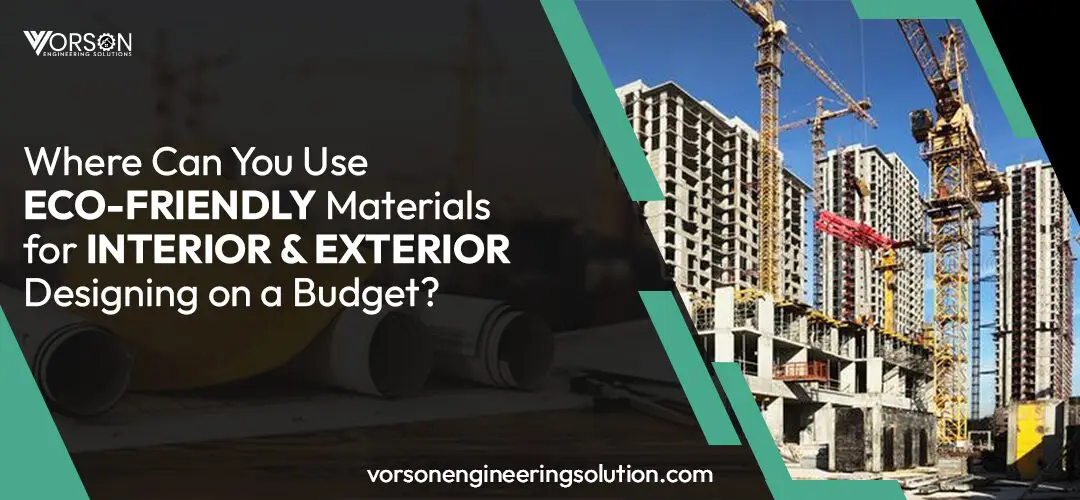The rising trend toward sustainable living has made eco-friendly materials popular for interior and exterior design. More people choose these choices to lower their carbon footprint and affordably create better living quarters. For home renovations and new buildings, environmentally friendly and reasonably priced eco-friendly materials for interior and exterior designing are sought.
This blog addresses applying sustainable materials to reasonably priced, stylish, functional designs.
Why Choose Eco-Friendly Materials?
Eco-friendly materials are not only good for the environment but also offer numerous benefits, including:
- Energy Efficiency: Many eco-friendly materials help conserve energy, reducing utility bills over time.
- Durability: These materials are often more robust than conventional options, ensuring long-term use.
- Health Benefits: Natural materials reduce exposure to harmful chemicals and improve indoor air quality.
- Aesthetic Appeal: Eco-friendly materials provide a unique and earthy aesthetic that enhances your space.
Eco-Friendly Materials for Interior Designing
Flooring Options
Flooring can significantly impact the look and feel of your interiors. Eco-friendly flooring materials offer beauty and sustainability at a reasonable price.
- Bamboo Flooring
Bamboo is a rapidly renewable resource, making it a top choice for eco-conscious homeowners. It’s durable stylish, and comes in various finishes. - Recycled Hardwood
Reclaimed or recycled hardwood offers a rustic charm while preventing deforestation. These options are often available at lower costs when sourced locally. - Cork Flooring
Made from the bark of cork oak trees, cork flooring is soft, resilient, and an excellent insulator. It’s ideal for areas requiring noise reduction.
Wall Treatments
Walls offer plenty of room for creativity and sustainability.
- Recycled Paint
To minimize harmful emissions, instead of buying new paint, opt for recycled or low-VOC (Volatile Organic Compounds) paint. - Natural Wallpaper
Wallpaper made from bamboo, cork, or jute provides an eco-friendly alternative to conventional options. - Clay Plaster
Clay plaster is a natural wall finish that provides a unique texture while improving indoor air quality.
Furniture and Decor
Eco-friendly furniture is both stylish and practical.
- Recycled Wood Furniture
Furniture made from reclaimed wood reduces waste and brings a touch of history to your home. - Natural Fabrics
Use organic cotton, hemp, or linen for upholstery, curtains, and cushions. These fabrics are biodegradable and free from harmful dyes. - Second-Hand Pieces
Thrift stores and flea markets are treasure troves for unique, budget-friendly furniture with minimal environmental impact.
Lighting Solutions
Lighting is crucial in interior design, and eco-friendly options can save energy while enhancing the ambiance.
- LED Lights
LED lights are highly energy-efficient, last longer, and are available in various designs. - Natural Light Integration
Maximize natural light by incorporating large windows or skylights to reduce daily electricity usage.
Kitchen and Bathroom Fixtures
Your kitchen and bathroom can also benefit from eco-friendly materials.
- Recycled Glass Countertops
These countertops are durable, stylish, and made from post-consumer glass. - Water-Saving Fixtures
Low-flow faucets and showerheads reduce water wastage without compromising functionality. - Recycled Tile
Tiles made from recycled glass or ceramic are durable and have stunning designs.
Eco-Friendly Materials for Exterior Designing
Sustainable Roofing
The roof is one of the most critical elements of exterior design.
- Cool Roofs
Cool roofs reflect more sunlight and absorb less heat, improving energy efficiency. They can be made from reflective coatings or recycled materials. - Metal Roofing
Metal roofing is durable, recyclable, and often made from recycled metals. - Green Roofs
A green roof involves planting vegetation on your roof, improving insulation and reducing heat.
Exterior Walls and Facades
Your home’s exterior makes the first impression, and eco-friendly materials can enhance its curb appeal.
- Reclaimed Wood Siding
Reclaimed wood siding is an excellent option for rustic charm and sustainability. - Recycled Brick
Recycled bricks are durable and give a timeless look to any structure. - Fiber Cement Siding
Made from natural materials, fiber cement siding is durable, fire-resistant, and low maintenance.
Outdoor Decking and Landscaping
Eco-friendly materials for outdoor spaces ensure durability and aesthetic appeal.
- Composite Decking
Composite decking, made from recycled wood and plastic, is low-maintenance and long-lasting. - Bamboo Decking
Bamboo is an affordable and sustainable option for outdoor decking. - Permeable Pavers
Permeable pavers allow water to seep through, reducing water runoff and improving drainage. - Native Plants
Planting native species in your garden reduces the need for excessive watering and maintenance.
Driveways and Pathways
- Recycled Concrete
Using recycled concrete for driveways and pathways reduces the demand for new materials and supports sustainability. - Gravel or Crushed Stone
These materials are cost-effective and blend well with natural landscapes.
Budget-Friendly Tips for Using Eco-Friendly Materials
Source Locally
Local materials are often cheaper and have a lower carbon footprint due to reduced transportation.
Repurpose and Reuse
Get creative by repurposing old furniture or materials for new uses.
DIY Projects
Take on small DIY projects to save labour costs while incorporating eco-friendly materials.
Buy in Bulk
Purchasing materials in bulk can reduce costs significantly.
Look for Sales and Discounts
Keep an eye out for sales on eco-friendly products to snag a deal.
Challenges of Using Eco-Friendly Materials
While eco-friendly materials offer many advantages, they may present particular challenges, such as:
- Initial Costs: Some materials, like bamboo or recycled glass, may have higher upfront costs.
- Limited Availability: Certain eco-friendly options may not be available in all regions.
- Specialized Installation: Some materials require skilled professionals for installation, which could increase labour costs.
To overcome challenges in creating sustainable spaces, consider researching, comparing suppliers, and consulting experts in eco-friendly design. Eco-friendly materials for interior and exterior designing, such as bamboo flooring and recycled glass countertops, offer sustainable, affordable, and stylish solutions for any space.
With careful planning and creativity, you can turn your home into an eco-friendly haven on a budget. Eco-friendly materials help the environment and improve your family’s health.
Start small, explore Vorson Engineering, and move toward sustainability.



